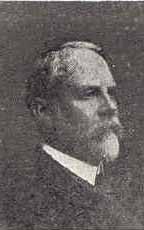![]() Robert Frederick Foster (1853–1945). Né en Écosse, ingénieur de
formation, il s’installe aux USA où il met rapidement sa plume et son
érudition à profit pour écrire sur de nombreux jeux. Une multitude d’articles
et de livres, dont certains témoignent d’un réel intérêt pour l’histoire
des jeux, en font certainement l’auteur le plus prolifique de son
époque. Après avoir grandement contribué à enrichir la littérature du
genre, et celle du bridge en particulier, il décède à l’âge vénérable de
92 ans. S’il écrit d’abord sur le whist, comme nous l’avons vu dans l’épisode
précédent, ses publications sur le bridge sont particulièrement
abondantes et reconnues.
Robert Frederick Foster (1853–1945). Né en Écosse, ingénieur de
formation, il s’installe aux USA où il met rapidement sa plume et son
érudition à profit pour écrire sur de nombreux jeux. Une multitude d’articles
et de livres, dont certains témoignent d’un réel intérêt pour l’histoire
des jeux, en font certainement l’auteur le plus prolifique de son
époque. Après avoir grandement contribué à enrichir la littérature du
genre, et celle du bridge en particulier, il décède à l’âge vénérable de
92 ans. S’il écrit d’abord sur le whist, comme nous l’avons vu dans l’épisode
précédent, ses publications sur le bridge sont particulièrement
abondantes et reconnues.
Il s’intéresse en fait à pratiquement tous les jeux de cartes en vogue à l’époque, tels l’euchre (sorte de triomphe américaine), le skat, la crapette, etc. sans oublier toutes sortes d’autres jeux, comme le mah-jong.
Il fait d’ailleurs partie du comité de standardisation de ce dernier pour les USA, en compagnie de Milton C. Work. À partir de 1897, il publie Foster’s encyclopedia of games un recueil de règles particulièrement riche et complet sur une vaste gamme de jeux, y compris le billard, constamment réédité jusqu’en... 1963.
Dès le bridge aux enchères, et bien avant Harold Vanderbilt et le bridge contrat, il imagine l’ouverture de 1♣ artificielle et forcing, ainsi que son indispensable complément, l’ouverture de 1SA faible. La technique du jeu de la carte, qu’il étudie passionnément dès le whist, lui doit également beaucoup, avec notamment l’entame en 4meilleure et la règle des onze, qu’il met au point à peu près en même temps que E.M.F. Benecke (à Oxford) et qu’il publie dans son célèbre Whist Manual.


